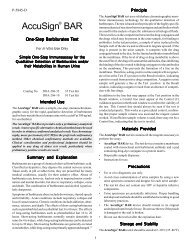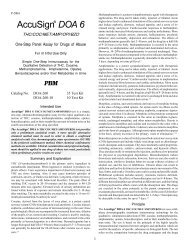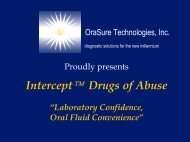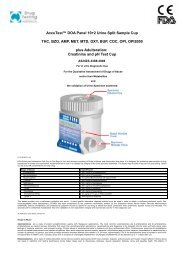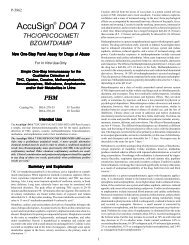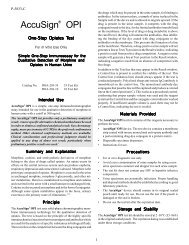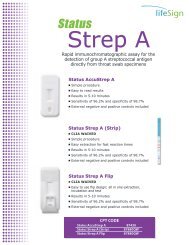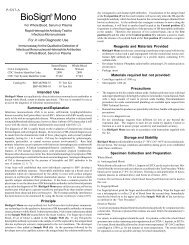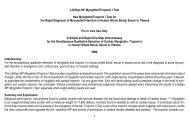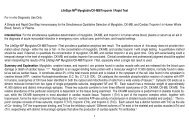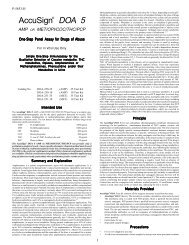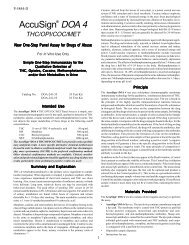AccuTest DOA Panel 9+2 Urine Split Sample Cup - Drug Testing
AccuTest DOA Panel 9+2 Urine Split Sample Cup - Drug Testing
AccuTest DOA Panel 9+2 Urine Split Sample Cup - Drug Testing
You also want an ePaper? Increase the reach of your titles
YUMPU automatically turns print PDFs into web optimized ePapers that Google loves.
Buprenorphine a derivative of thebaine, is an opioid that has been marketed in the United States as the Schedule V parenteral analgesic Buprenex. In 2003, based on a<br />
reevaluation of available evidence regarding the potential for abuse, addiction, and side effect, DEA reclassified buprenorphine from a Schedule V to a Schedule III narcotic.<br />
Buprenorphine resembles morphine structurally but has a longer duration of action than morphine and can be administrated sublingually as an analgesic. In October 2002, FDA<br />
approved the use of a buprenorphine monotherapy product, Subutex, and a buprenorphine/naloxone combination product, Suboxone, for the treatment of opioid addiction. Subutex<br />
and Suboxone are the first narcotic drugs available under the US <strong>Drug</strong> Act (DATA) of 2003 for the treatment of opiate dependence that can be prescribed in the US in a physician’s<br />
work place. It has also been shown that buprenorphine has abuse potential and may itself cause dependency. In addition, a number of deaths have been recorded as a result of<br />
overdose with intravenously injected buprenorphine in conjunction with other psychotropic drugs such as benzodiazepines. Buprenorphine is metabolized primarily by n-dealkylation<br />
to form glucuronide-buprenorphine and glucuronide-norbuprenorphine.<br />
Cocaine Derived from the leaves of cocoa plant, cocaine is a potent central nervous system stimulant as well as a local anesthetic. Some of the psychological effects induced by<br />
cocaine are: euphoria, confidence and a sense of increased energy, accompanied by increased heart rate, dilation of the pupils, fever, tremors and sweating. Continued ingestion of<br />
cocaine could induce tolerances and physiological dependency which leads to its abuse. Cocaine is used by smoking, intravenous, intransal or oral administration and excreted in the<br />
urine primarily as benzoylecgonine in a short period. Benzoylecgonine has a biological half-life of 5 – 8 hours, which is much longer than that of cocaine ( 0.5 – 1.5 hours), and can<br />
be generally detected for 12 – 72 hours after cocaine use or exposure.<br />
Methadone is a synthetic opioid, clinically available. It is used clinically for the treatment of severe pain and in maintenance programs for morphine and heroine addicts. Methadone<br />
acts on the central nervous and cardiovascular systems to produce respiratory and circulatory depression. Methadone also produces miosis and increases the tone of smooth<br />
muscle in the lower gastrointestinal tract while decreasing the amplitude of contractions. Acute higher doses induce analgesia, sedation, respiratory depression and coma. After<br />
methadone administration, the major urinary excretion products are methadone and its metabolites, EDDP and EMDP. Large individual variations in the urine excretion of methadone<br />
are output of methadone from 5-22%. Typically, following a 5 mg oral dose, methadone and EDDP account for 5% of the dose in the 24-hour urine. In those individuals on<br />
maintenance therapy, methadone may account for 5 to 50% of the dose in the 24-hour urine and EDDP may account for 3 to 25% of the dose.<br />
Methamphetamine is the most popular systhetic derivative of the amphetamines. It is a potent sympathomimetic agent with therapeutic applications. Acute large doses lead to<br />
enhanced stimulation of the central nervous system and induce euphoria, alertness, reduced appetite, and a sense of increased energy and power. More acute response produces<br />
anxiety, paranoia, psychotic behavior, and cardiac dysrhythmias. Methamphetamine is excreted in the urine as amphetamine and oxized and deaminated derivatives. However, 10-<br />
40% of methamphetamine is excreted unchanged. Methamphetamine is generally detectable in the urine for 3 to 5 days after use.<br />
Opiate Opioid analgesics comprised of a large group of substances that control pain by depressing the central nervous system. Acute high dose used by abusers or addicts can<br />
cause depressed coordination, disrupted decision, decreased respiration, hypothermia and coma. Morphine is excreted unmetabolized and is the marker metabolic product of<br />
opiates. Morphine and morphine glucuronide is detectable in urine for several days after opiates dose.<br />
Oxycodone is known as Oxycontin, Roxicodone and is an ingredient of Percodan, Percocet, Roxicet and Tylox. Oxycodone is a semi-synthetic opiates derived from opium. Like<br />
other opiates, oxycodone is characterized by its analegestic properties, and the tendency for users to form a physical dependency and develop tolerance with extended use.<br />
Oxycodone is usually administered in combination with non-opiate analegesics such as acetaminophen and salicylates for the relief of moderate to severe pain. Oxycodone is a<br />
central nervous system depressant that may cause drowsiness, dizziness, lethargy, weakness and confusion. Toxicity in an overdose of oxycodone can lead to stupor, coma, muscle<br />
flaccidity, severe respiratory depression, hypotension, and stripiac arrest. Oxycodone is metabolized by N- and O-demethylation. One of the metabolites, oxymorphone, is a potent<br />
narcotic analgesic, while the other, noroxycodone, is relatively inactive. Between 33 to 61% of a single dose of oxycodone is excreted in a 24 hour urine collection and consists of 13-<br />
19% free oxycodone, 7-29% glucuronide conjugated oxycodone, 13-14% glucuronide conjugated oxymorphone and an unknown amount of noroxycodone. The detection time<br />
window of oxycodone is 1-3 days following use.<br />
THC The agents of Marijuana that cause various biological effects in humans are called cannabinoid. Cannabinoid is a central nervous stimulant that alters mood and sensory<br />
perceptions, produces loss of coordination, impairs short term memory, and produces symptoms of anxiety, paranoia, depression, confusion, hallucination, and increased heart rate.<br />
Large doses of cannabinoid could cause the development of tolerances and physiological dependency and lead to abuse. A tolerance to the cardiac and psychotropic effects can<br />
occur and withdrawal syndrome produces restlessness, insomnia, anorexia and nausea. ∆ 9 -THC is the primary active ingredient in cannabinoids. The main metabolite excreted in the<br />
urine is 11-nor-∆ 9 -THC-9-COOH, which are found within hours of exposure and remain detectable in the urine for 3-10 days after smoking.<br />
Adulteration Test<br />
Adulteration test is built-in strips to help to verify the integrity of the urine specimen to be tested. Only fresh and uncentrifuged urine samples without preservatives are to be used.<br />
The standard Adulteration test provides tests for Creatinine (C) and pH(P). Other test parameters are available as custom order. These parameters are Nitrite (N), Specific Gravity<br />
(G), Glutaraldehyde (U), Bleach (B), and Pyridinium Chlorochromate (P). Test results may be useful for assessing the integrity of the urine sample while running <strong>Drug</strong>s-of-Abuse<br />
testing, for example, whether the sample is possibly diluted with water or other liquids as indicated by the Creatinine and specific gravity tests. <strong>Urine</strong>Check detects whether the<br />
sample contains commercially available adulterants including nitrite, Glutaraldehyde, and other oxidizing agents. <strong>Urine</strong>Check can also assess whether the sample is possibly<br />
contaminated by acidic (vinegar) or basic (ammonia solution) adulterants as indicated by the pH test.<br />
PRINCIPLE<br />
<strong>Drug</strong>s of Abuse<br />
Each component strip of <strong>DOA</strong> <strong>Panel</strong> is based on the principle of specific immunochemical reaction between antibodies and antigen to analyze particular compound in human urine<br />
specimen. The assay relies on the competition for binding antibody. When drug is present in the urine specimen, it competes with drug conjugate for the limited amount of antibodydye<br />
conjugate. When the amount of drug is equal or more than the cut-off, it will prevent the binding of drug conjugate to the antibody. Therefore, a positive urine specimen will not<br />
show a colored band on the test line zone, indicating a positive result, while the presence of a colored band indicates a negative result.<br />
A control line is present in the test window to work as procedural control. This colored band should always appear on the control line zone if the test device is stored in good condition<br />
and the test is performed appropriately.<br />
Adulteration Test<br />
In general, all Adulteration tests are based on the chemical reactions of the indicator reagents on the pads with components in the urine sample effecting color changes. Results are<br />
obtained by comparing the color on each of the test pads with the corresponding pad on the color chart provided.<br />
Creatinine: <strong>Testing</strong> for sample dilution. In this assay, Creatinine reacts with a Creatinine indicator in an alkaline condition to form a purplish- brown color complex. The<br />
concentration of Creatinine is directly proportional to the color intensity of the test pad.<br />
pH: <strong>Testing</strong> for the presence of acidic or alkaline adulterant. This test is based on the well-known double pH indicator method that gives distinguishable colors over wide pH range.<br />
The colors range from orange (low pH) to yellow and green to blue (high pH).<br />
MATERIALS PROVIDED<br />
<strong>DOA</strong> <strong>Panel</strong> plus Adulteration Test <strong>Cup</strong><br />
<strong>Drug</strong>s Of Abuse<br />
The amount of each coated antigen and/or antibody on the strip is less than 1.0 mg for antigen conjugate and is less than 1.0 mg for goat anti-mouse IgG antibody.<br />
Test zone: contains drug bovine protein antigen conjugates<br />
Control zone: contains Goat anti-rabbit IgG antibody<br />
Conjugate pad: contains mice monoclonal anti-drug antibody.<br />
Adulteration Test<br />
Instruction for use<br />
MATERIAL REQUIRED BUT NOT PROVIDED<br />
1. Timer or clock.



